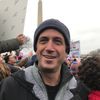On Monday the San Francisco 49ers beat the Atlanta Falcons in what may be the last game ever played at Candlestick Park, but for me Candlestick Park ended on September 30, 1999 when Eric Karros picked up a ground ball struck by Marvin Benard and touched for first base for the last out of a 9-4 Dodger victory over the Giants. As I sat in my not very good seats with my brother and several friends and watched the last out, I thought that losing to the Dodgers was a sad, but somehow fitting way for the Giants to end their almost 40 year run at Candlestick Park.
The 49ers, Candlestick's other longtime tenant, continued to play there until this week. I am a much bigger fan of baseball than of football, but nonetheless after the Giants moved to their new, and frankly better, ballpark, it was always comforting to see Candlestick off to the right as I would ride in from the airport on my too infrequent visits to San Francisco. I even managed to attend a 49er game or two with my sons there in recent years.
The Giants, for their part, have achieved unprecedented success since moving to their new ballpark, winning two World Championships, selling out countless games and building an enormous local, and significant national, following. That success, along with the better weather, food, and views of the game made it relatively easy for the Giants to abandon Candlestick for what is now AT&T Park. The 49er story is different. They are not just leaving the ballpark, but the city as well.
Candlestick Park was never a great place to watch a baseball game, especially compared to the newer stadiums built in the last twenty years or so. It was big with no seats particularly close to the field, often empty, and located in a relatively remote quarter of the city. Nonetheless, its reputation as the worst ballpark in the big leagues was only half deserved. In the daytime, it could be quite nice with balmy weather and ample sun, but as the sun set it could drop 10 or 20 degrees in an inning or two. For night games, Candlestick had a well deserved reputation for being extremely cold and windy. The wind also gave the ballpark some strange local color as it was the only ballpark in the big leagues where napkins, hot dog wrappers other detritus were frequently blowing around in circles in the outfield, infield, on deck circles and anywhere else. Occasionally some fans would sneak up to desolate areas of the upper deck and throw handfuls of napkins or even All-Star ballots over the field just to watch the wind take them.
Candlestick was one of the first of the spate of multi-use stadiums built in cities across the U.S. in the 1960s and 1970s. Very few, if any, of these stadiums are still in use. They are relics of time when sports were a smaller business and practicality and access were more important considerations than the question of how many luxury boxes could be sold. The new ballparks, as a whole, are better places to watch a ballgame, but they are also more expensive, louder and have generally removed the sport itself from the focus of the experience.
For over half a century, Candlestick Park has been one of the most famous and recognizable, if not pleasant or attractive, buildings in San Francisco, but it will be demolished sometime in the coming months or years. It is difficult not to see the imminent demolition of Candlestick Park as a symbol for something in today's San Francisco. San Francisco, like all cities, is in transition, but the transition has accelerated in recent years as a city that was once a quirky and cool provincial town that punched well above its weight in culture and progressive politics, is looking more like a playground for the rich while many others are being priced out. It is consistent with these developments that the 49ers will be leaving the city for Santa Clara County where they will be closer to the center of Silicon Valley power and wealth, but physically and economically out of reach for many of their most faithful fans.
San Francisco without Candlestick Park, or a professional football team, will still be a great city, but it will not be the same. The 'Stick was a symbol that despite the extraordinary diversity, liberal attitudes and cosmopolitan nature of San Francisco, it also had a tough feeling ballpark that was home to two teams. Now that symbol, and that reality, is no longer there. All cities change all the time. Either that or they stop being significant cities, but the end of Candlestick Park means the end of, not a chapter, but a long story, of San Francisco.
